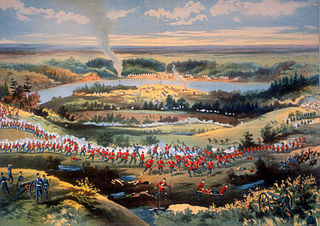
The North-West Rebellion, also known as the North-West Resistance, was an armed resistance movement by the Métis under Louis Riel and an associated uprising by First Nations Cree and Assiniboine of the District of Saskatchewan against the Canadian government. Many Métis felt that Canada was not protecting their rights, their land, and their survival as a distinct people.

Events from the year 1885 in Canada.
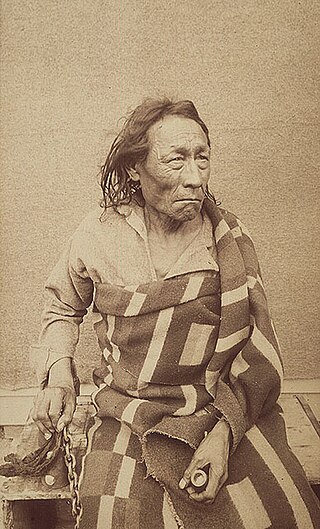
Big Bear, also known as Mistahi-maskwa, was a powerful and popular Cree chief who played many pivotal roles in Canadian history. He was appointed to chief of his band at the age of 40 upon the death of his father, Black Powder, under his father's harmonious and inclusive rule which directly impacted his own leadership. Big Bear is most notable for his involvement in Treaty 6 and the 1885 North-West Rebellion; he was one of the few chief leaders who objected to the signing of the treaty with the Canadian government. He felt that signing the treaty would ultimately have devastating effects on his nation as well as other Indigenous nations. This included losing the free nomadic lifestyle that his nation and others were accustomed to. Big Bear also took part in one of the last major battles between the Cree and the Blackfoot nations. He was one of the leaders to lead his people against the last, largest battle on the Canadian Plains.
The Battle of Frenchman's Butte, fought on May 28, 1885, occurred when a force of Cree, dug in on a hillside near Frenchman's Butte, was unsuccessfully attacked by the Alberta Field Force. It was fought in what was then the District of Saskatchewan of the North-West Territories.

David Lynch Scott was a Canadian militia officer, lawyer, and judge. He served as mayor of Orangeville, Ontario, mayor of Regina, Saskatchewan and Chief Justice of Alberta.
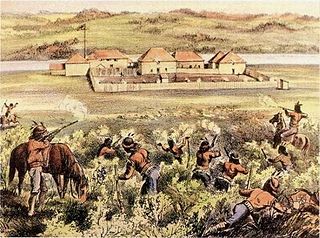
The Battle of Fort Pitt was part of a Cree uprising coinciding with the Métis revolt that started the North-West Rebellion in 1885. Cree warriors began attacking Canadian settlements on April 2. On April 15, they captured Fort Pitt from a detachment of North-West Mounted Police.
The Battle of Loon Lake, also known as the Battle of Steele Narrows, concluded the North-West Rebellion on June 3, 1885, and was the last battle fought on Canadian soil. It was fought in what was then the District of Saskatchewan of the North-West Territories, at what is now known as Steele Narrows at Makwa Lake, in Saskatchewan's Steele Narrows Provincial Park. Steele Narrows is a channel that separates Sanderson Bay from Makwa Lake.

The Frog Lake Massacre was part of the Cree uprising during the North-West Rebellion in western Canada. Led by Wandering Spirit, young Cree men attacked officials, clergy and settlers in the small settlement of Frog Lake in the District of Saskatchewan in the North-West Territories on 2 April 1885. Nine settlers were killed in the incident.
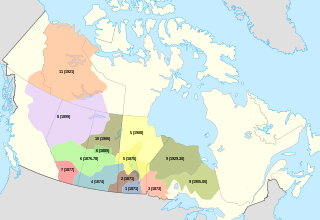
Wandering Spirit was a Cree war chief of a band of Plains Cree. There is little information on Wandering Spirit's life. Most of what is known begins shortly before the 1885 Frog Lake Massacre and ends with the Canadian justice system's convicting him of murder and hanging him. However, there is some information regarding his role within the Plains Cree people.

Beaver River is a large river in east-central Alberta and central Saskatchewan, Canada. It flows east through Alberta and Saskatchewan and then turns sharply north to flow into Lac Île-à-la-Crosse on the Churchill River which flows into Hudson Bay.
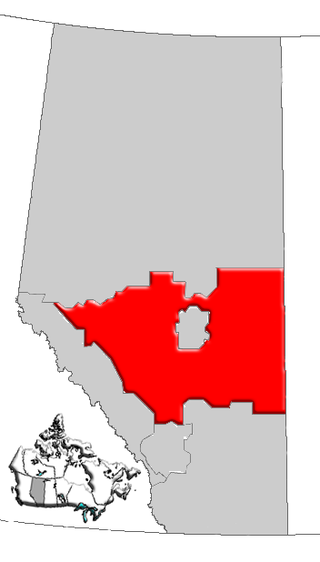
Central Alberta is a region located in the Canadian province of Alberta.

Francis Jeffrey Dickens was the third son and fifth child of Victorian English novelist Charles Dickens and his wife Catherine Dickens née Hogarth.

The Fort McKay First Nation (FMFN) is a First Nations government in northeast Alberta comprising five Indian reserves – Fort McKay 174, Fort McKay 174C, Fort McKay 174D, Namur Lake 174B and Namur River 174A. The FMFN, signed to Treaty 8, is affiliated with the Athabasca Tribal Council and its members are of Cree, Metis and Dene heritage. The FMFN's traditional lands include portions of the Athabasca oil sands.

The Looting of Battleford began at the end of March, 1885, during the North-West Rebellion, in the town of Battleford, Saskatchewan, then a part of the Northwest Territories.
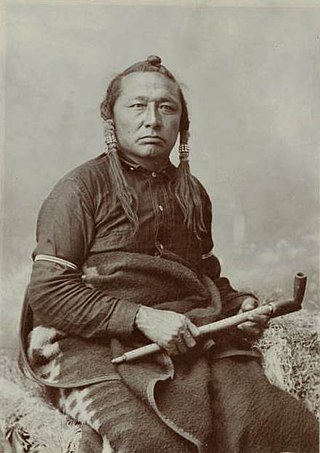
Little Bear was a Cree leader who lived in the District of Alberta, Idaho Territory, Montana Territory, and District of Saskatchewan regions of Canada and the United States, in the 19th and early 20th centuries. He is known for his participation in the 1885 North-West Rebellion, which was fought in Alberta and Saskatchewan.

Saskatchewan River fur trade The Saskatchewan River was one of the two main axes of Canadian expansion west of Lake Winnipeg. The other and more important one was northwest to the Athabasca Country. For background see Canadian canoe routes (early). The main trade route followed the North Saskatchewan River and Saskatchewan River, which were just south of the forested beaver country. The South Saskatchewan River was a prairie river with few furs.
The Iron Confederacy or Iron Confederation was a political and military alliance of Plains Indians of what is now Western Canada and the northern United States. This confederacy included various individual bands that formed political, hunting and military alliances in defense against common enemies. The ethnic groups that made up the Confederacy were the branches of the Cree that moved onto the Great Plains around 1740, the Saulteaux, the Nakoda or Stoney people also called Pwat or Assiniboine, and the Métis and Haudenosaunee. The Confederacy rose to predominance on the northern Plains during the height of the North American fur trade when they operated as middlemen controlling the flow of European goods, particularly guns and ammunition, to other Indigenous nations, and the flow of furs to the Hudson's Bay Company (HBC) and North West Company (NWC) trading posts. Its peoples later also played a major part in the bison (buffalo) hunt, and the pemmican trade. The decline of the fur trade and the collapse of the bison herds sapped the power of the Confederacy after the 1860s, and it could no longer act as a barrier to U.S. and Canadian expansion.

The Athabasca Landing Trail was a long-distance portage route that linked Fort Edmonton on the North Saskatchewan River with Athabasca Landing on the Athabasca River. The distance of the trail between Fort Edmonton and Athabasca Landing was 100 miles (160 km), giving the trail the nickname "The 100 Mile Portage."
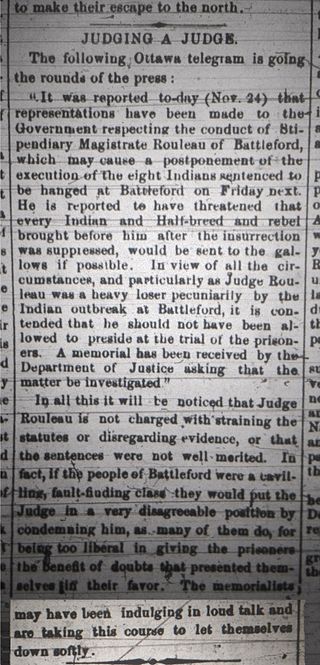
The hangings at Battleford refers to the hanging on November 27, 1885, of eight Indigenous men for murders committed in the North-West Rebellion. The executed men were found guilty of murder in the Frog Lake Massacre and in the Looting of Battleford. These murders took place outside the military combat that took place during the North-West Rebellion.
















